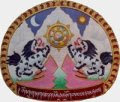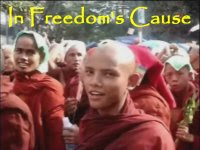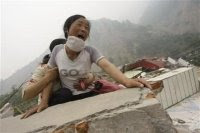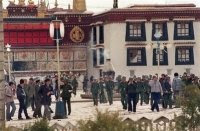Agam's Gecko


Monday, May 19, 2008
TIBET'S FEARLESS NUNS AND UNREQUITED COMPASSION
| M |
onks at a number of monasteries across Tibet which have suffered armed raids, searches, arrests, beatings and willful damage at the hands of Chinese security forces over the past two months, held prayer rituals and made donations for the victims of the Sichuan earthquake last week. Participating institutions included Drepung, Kirti and Lithang Monasteries in Lhasa, Amdo and Kham respectively -- as well as many others -- writes the Tibetan citizen journalist in her latest bulletin. The government's "work team" at Kirti has limited the ceremonies the monks had wished to carry out.
She also takes the opportunity to correct some false foreign media reports, which I'm sure the recently-angry Chinese nationalists will be able to get behind. Certain Western media had reported that Wenchuan, the epicentre of the quake, was a location where recent Tibetan protests "were very intense." Actually, in other parts of Ngaba Prefecture, Amdo (north-west Sichuan province) protests have certainly been intense. But in Wenchuan and the nearby areas, known in Tibetan as the Gyalrong region, the only demonstrations were supportive actions by Tibetan students in a few of the schools. However, many of the people arrested elsewhere in Ngaba were indeed held in prisons in Wenchuan and Dujiangyan, among the hardest hit places.
The government of the "Tibetan Autonomous Region" announced a donation campaign for people in the area affected by the quake, with official media claiming that it is "the most moving and the largest voluntary donation campaign organized by common people in Lhasa in recent years." Citizen journalist writes that in reality, the work units are deducting the donations directly from their employees' salaries according to rank. It's really quite moving. For example, the TAR Drama Troupe employees' paychecks are docked either 300 or 500 yuan.
On May 11 - 12, despite the massive security presence in Kardze County, Kham (Ch: Sichuan), fourteen nuns protested the earlier detention of two nuns from Drakkar Nunnery on April 23; they were arrested and beaten, according to reports received by Radio Free Asia.
"They protested in support of those two nuns who protested April 23 and were detained. These nuns shouted for the independence of Tibet, and for the long life and return of His Holiness the Dalai Lama," one source said. "They protested right at the center of Kardze town, close to the local TV station."(The Tibetan Centre for Human Rights and Democracy confirms the arrests, with name lists.)
"Chinese security forces rounded them up and beat them. They severely assaulted one of the nuns, Taga, by striking her head against the pavement. She was bleeding profusely. Bloodstains were found on the pavement where the nuns were detained and beaten up."
RFA also confirms the Tibetan citizen journalist's report early this month (reported here May 7) of a number of nuns and one layperson in Drango County, Kardze being sentenced to prison terms. The sentences were announced April 29, but it's now reported that four nuns (not three) received seven years of prison time, while three other nuns and the layperson were handed three years (name list on the RFA page).
Two reports recently added to the excellent TibetInfoNet database refer to incidents I haven't seen reported elsewhere. Phenpo Lhundrup county is just north of the city, in Lhasa municipality.
Lhasa April 14, 2008An official of the Tibetan government in exile says they have completely lost contact with Tibetans living in Ngaba Prefecture since the earthquake. Monks at Drepung Monastery in Lhasa held their prayer ceremony last Wednesday on behalf of people of the affected areas. Demonstrations against the repression of Chinese authorities also continued last week, with nuns distributing leaflets and monks expressing freedom slogans. At least 27 people were arrested.
Circa 14 April: Officials reportedly showed photographs of recent Tibetan demonstrations outside the Chinese consulate in New York City, to Tibetans in Lhasa with relatives in exile; upon recognition of relatives, the Lhasa residents were given a warning that to avoid difficulties, they must tell their relatives to stop demonstrating.
(reported by sources to TibetInfoNet, 17 April 2008)
Shar Bumpa nunnery, Phenpo Lhundrup county (Chin: Lingzhi Xian)
Date unspecified (between mid March and mid April): Reportedly, 62 nuns removed from Shar Bumpa nunnery; some imprisoned, others staying with relatives, several of whom require medical attention following beatings by security personnel but refused treatment in hospital or local clinics. An elderly nun named named Tashi Lhadock, who is partially deaf, was interrogated and beaten; her skull was broken and she was hospitalised. Two elderly nuns remain at Shar Bumpa nunnery.
(reported by sources to TibetInfoNet, 09 May 2008)
In Dzamthang County, Ngaba Prefecture on April 29, a monk named Kunchok from Sangloong monastery was arrested for shouting freedom slogans in front of the local Public Security Bureau office. On May 3 two fellow monks, Paljor and Dorjee Drakpa pleaded for his release, and were arrested and beaten by PSB officers.
Ten nuns in Kardze County, Kham (Ch: Sichuan) mounted a peaceful protest at county headquarters on May 12, and were arrested by PSB and PAP officers. Some of the nuns, including one named Tragha, were badly beaten. The following day three monks from Kardze monastery came to protest peacefully at the same office. Lobsang Choeden, Palden Tsultrim and Lobsang Tenpa were all arrested.
The elderly former head of Rong Gonchen (or Rongwo, or Rongpo) monastery in Rebkong County, Malho Prefecture, Amdo (Ch: Qinghai), Alak Khasutsang, who was badly beaten by security forces on April 17, remains in a Siling hospital with a broken leg. He was earlier reported in critical condition. In the same county three Tibetans from the Dowa area who demonstrated on March 17, and were arrested on March 22, were then arbitrarily sentenced on March 24. The duration of the sentences for Chan Khargyal, 17, Choepa, 20 and Tralo, 19, are not clearly known. They are not allowed visitors. This may be a confirmation of Tibetan citizen journalist's report, carried here on May 7, of a secret trial which sentenced "three monks from Dowa Monastery."
Reports are still coming of previously unknown arrests during the first days of the uprising. In Thewo County, Kanlho Prefecture, Amdo (Ch: Qinghai) a large group of local people from Drak-gham village mounted a peaceful procession to county headquarters on March 17, shouting freedom slogans and carrying portraits of Dalai Lama. They were stopped and dispersed along the way, while some were beaten. More than 100 laypeople and monks were arrested a few days later by PSB and PAP officers. Two villagers, Pema Kyab and Sonam Lobsang, were hospitalised with severe injuries after their beatings. Some were later released with payment of up to 5,000 yuan, and others will be sentenced later.
The husband was identified as Shelok, 63 and retired from the Chinese border patrol. The wife, Yangdzom, works in retirement as a doctor at the Lhasa People’s Hospital, one source said. Yangdzom’s age wasn’t immediately available.Shelok and Yangdzom's two children, who had been studying in China, returned to find the family home looted.
"On May 3, Shelok was taken away from his residence between midnight and 1 a.m.," the source said.
"He was accused of passing information about the death and detention of Tibetan protestors [and about] the conditions of prison to his sources outside Tibet. He was also accused of helping Tibetan protestors in the hospital. He was taken to Gutsa prison."
Yangdzom was detained three days after her husband, the sources said. "She was accused of secretly taking painkillers and other medications from the hospital to treat Tibetans injured in the protests. Where she was taken isn’t known."
At two monasteries in Markham County, Chamdo Prefecture (in the eastern "TAR"), Chinese officials have been "re-educating" the monks since the beginning of April. There have been many of these efforts over the past two months, all over the plateau. But what can the Chinese "work teams" do, when the monks won't follow their orders?
They are directed to issue verbal denunciations, to sign written denunciations, to pledge allegiance to the Party, to raise the red flag, take two steps sideways and touch their noses with their elbows, or who knows what else. They simply refuse to do the prescribed dance. In a number of cases, the monks of a monastery have all gathered before the most sacred image in the entire place, and pledged that they would rather die.
Which basically means that the re-education didn't work. "Patriotic" re-education has been going on in Tibet for more than a decade, and it has failed spectacularly. But in 2008, its failure couldn't be more absolute. So the "work teams" have started to kick things up another notch. You won't be re-educated into our patriotism? You're under arrest.
On May 10 the "work team" came to conduct more rigorous indoctrination at Woeser Monastery and Khenpa Lungpa Monastery in Garthog township, Markham. There were arguments with the monks (there are fewer than 100 at each institution) who refused to write the desired statements or to sign the proffered documents. No law is broken by refusing to be coerced into doing these things. On May 12, ten monks of Khenpa Lungpa were arrested. The next day, six monks of Woeser were arrested. The day after that, two other local Tibetans were also arrested. Tibetan citizen journalist confirms the arrests, adding that the detainees were paraded through the streets on a truck, with black sacks pulled over their heads. This is freedom of religion in the "People's Republic."
The two monasteries are described as desolate places now; the remaining monks solemnly left the institutions and returned to their homes. If one is to be arrested for staying true to his conscience and faith, who can blame them? The local Buddhists now have nowhere to turn. The Tibetan Centre for Human Rights and Democracy has more details, a name list of those arrested, photographs of most of them, and a painting of Woeser Monastery, at the link.
More than 60 nuns of Pangri-Na Nunnery in Sib-ngo township, Kardze County, Kham (Ch: Sichuan province) mounted a peaceful protest at the county headquarters at about 5 pm on May 14. PSB and PAP officers inflicted severe beatings while arresting 52 of them; the others escaped. "Work teams" were dispatched to "re-educate" the remaining nuns, who must be a pretty tough lot as the "work teams" were forced to escape the nunnery under the "strong opposition" of the 16 who were left there.
The Tibetan Centre for Human Rights and Democracy confirms the arrests, adding that the nuns were objecting to the killings, torture and arrests going on all over their country, the slanders against Dalai Lama by the government, and the forced "patriotic" re-education programme. They had previously vowed never to take part in this political campaign "at any cost."
The nuns made a proclamation amongst themselves that, "It is better to die than to denounce, criticize and attack the Dalai Lama, to sign official documents denouncing the Dalai Lama, if there is no place for us to worship and live, let us go somewhere else or die, if the Chinese authorities kill us, let us be killed, we have no regrets."A name list of the 55 detained nuns is available on that page.
Shortly after the end of the meeting, on 14 May 2008, around 5 PM (Beijing Standard Time), defying the gun wielding Chinese security forces and intense government restriction, the nuns grouped themselves at the Kardze bridge, and then marched straight to the Kardze County government headquarter chanting slogans "Independence for Tibet", "Long Live the Dalai Lama" and "The Dalai Lama to return to Tibet".
When the protesting nuns neared the County government headquarter, the personnel of Public Security Bureau (PSP) and People's Armed Police (PAP) immediately arrested the protesting nuns, bundled up and thrown them into police vehicles and taken into custody within minutes. More than 55 nuns were arrested on the spot and their torn and fallen robes and clothes were reportedly scattered on roads. No one picked up the nuns' robes for fear of being arrested by the security forces. Eyewitnesses say the nuns shouted slogans and threw pamphlets into air while taken away in police vehicles for detention.
On the same day, nuns from Gaden Choeling Nunnery in Kardze protested peacefully at the county office, and four were arrested. This makes for three separate protests in Kardze County on the same day.
The Tibetan Centre for Human Rights and Democracy confirms the arrests, with more details. This group of nuns was blocked by PSB and PAP officers at Kardze Bridge, but a few were able to skirt the security cordon and reach the county headquarters. They shouted freedom slogans, and within minutes were arrested and badly beaten.
Also on the same day, May 14 in Serthar County -- also in Kardze Prefecture, Kham (Ch: Sichuan) -- 22 year-old monk Bhumgha mounted a lone protest, and was arrested by PSB officers.
Another of the Labrang monks who protested in front of international journalists on April 9, is reported to have been arrested at the beginning of May. It isn't known where Drakpa, a monk from Gyuto Monastery in Sangchu County, Kanlho Prefecture, Amdo (Ch: Gansu) is being held. Tibetan citizen journalist adds that the two monks who had "disappeared" within days of the incident, Thabkhey and Tsundue, are believed by local residents to have already been killed.
A newly reported protest on March 18 was held by the monks of Thangsar Monastery, along with local people in Mey-shul township in Sangchu County. Authorities detained 23 protesters, but some were later released after cash payments.
The Jokhang Temple, Tibet's most sacred place, re-opened on Friday according to state-controlled media. The temple had been sealed since March 10, as were the three large monasteries around Lhasa. A stage managed foreign media tour of the Jokhang went haywire for the authorities when resident monks conducted an unauthorized press briefing, and expressed their true aspirations to the world. There is still no word on their fate, and phone calls to the temple are currently going unanswered.
.











 Our way of saying "thanks" in the Thai way. Here a nak muay Thai (kickboxer) offers respect and thanks for his teacher (wai khru) before a match. This is our local variation on the ubiquitous "hat tip" used in general blog culture.
Our way of saying "thanks" in the Thai way. Here a nak muay Thai (kickboxer) offers respect and thanks for his teacher (wai khru) before a match. This is our local variation on the ubiquitous "hat tip" used in general blog culture.







